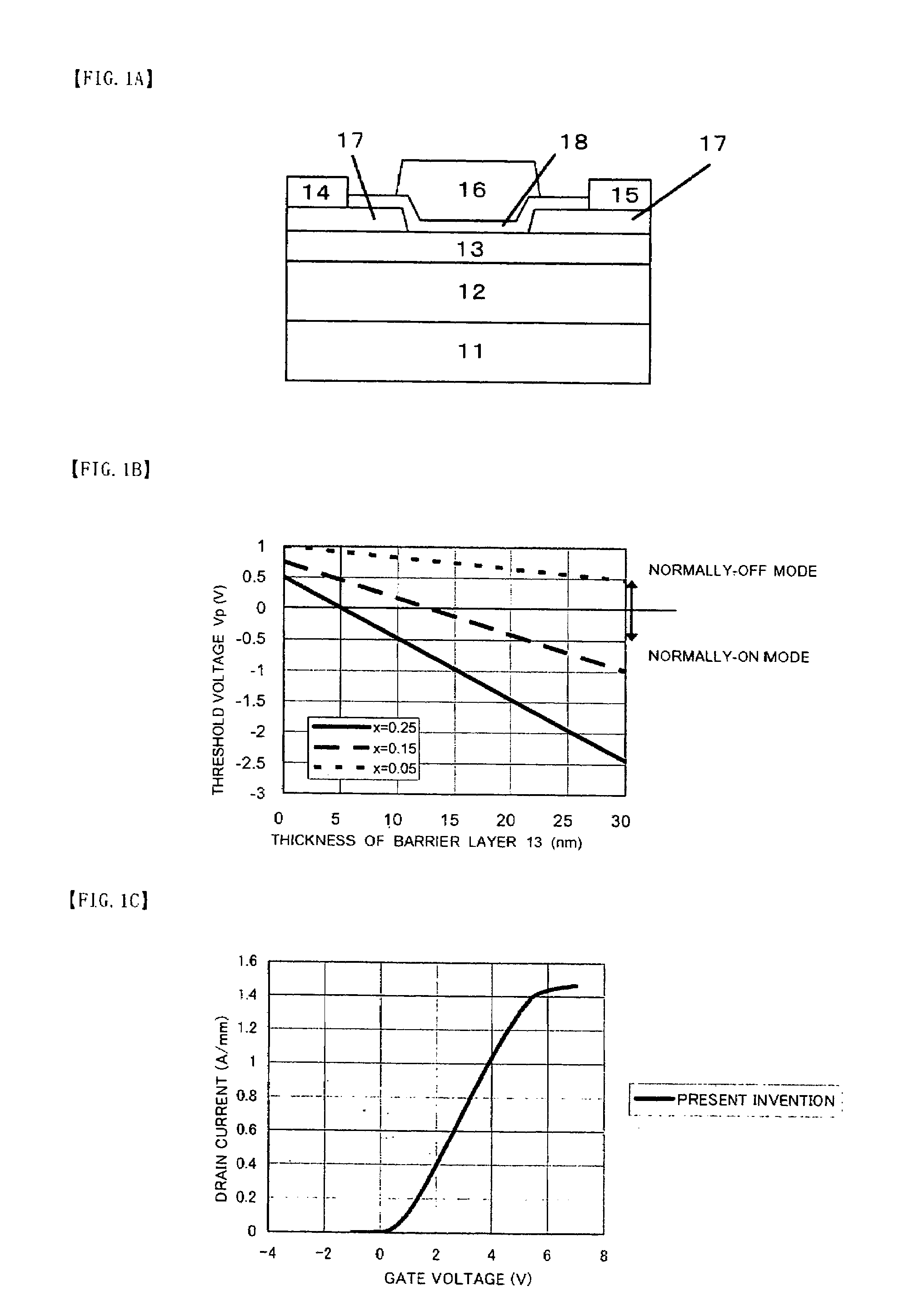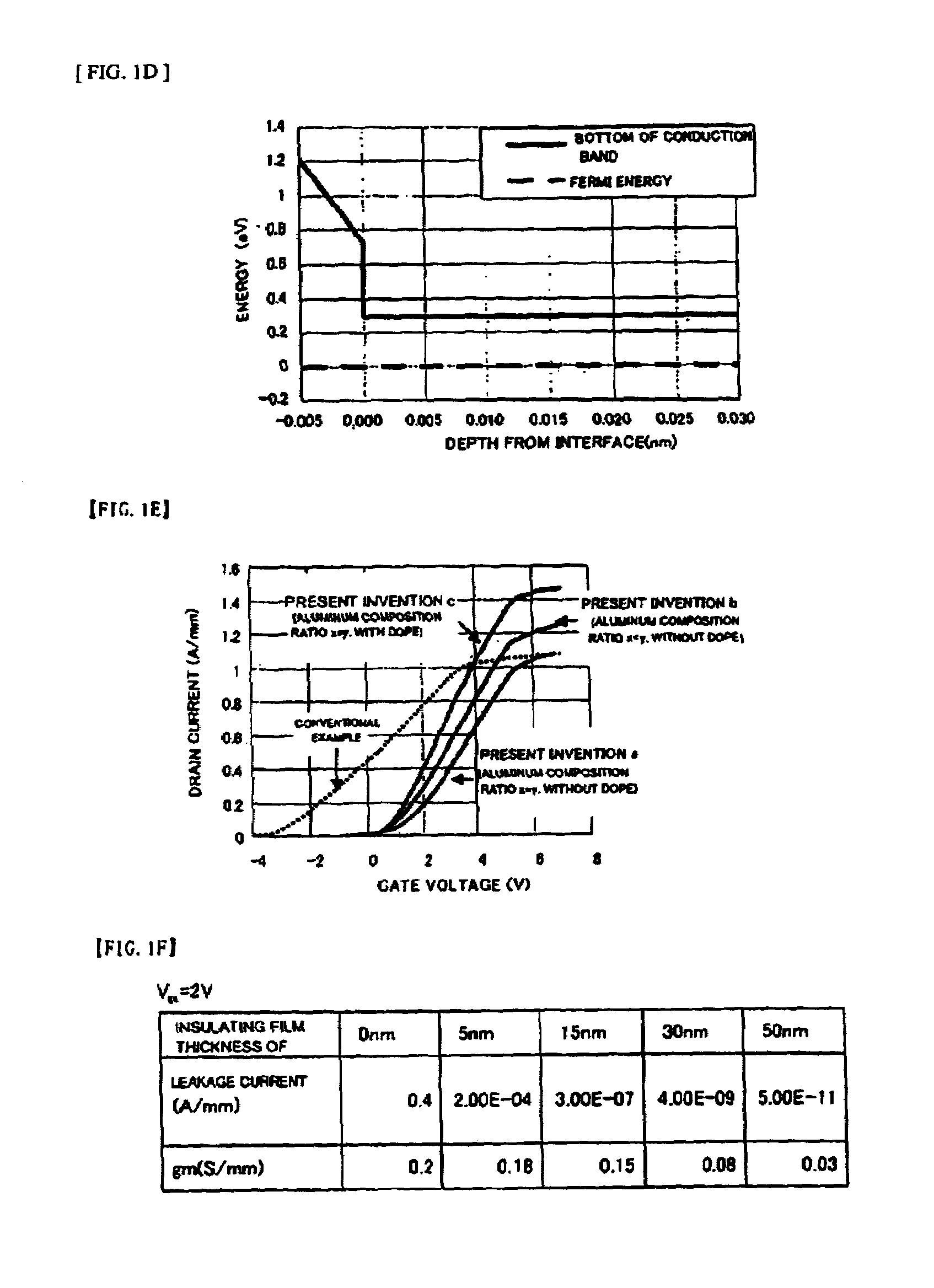Semiconductor device
a technology of semiconductors and devices, applied in the field of semiconductor devices, can solve the problems of reducing the current output to the drain electrode, not being suitable for use as a switch for the power source system, and not being suitable for the use of the third electrode as a switch, etc., and achieve the effect of reducing the leakage current to the third electrod
- Summary
- Abstract
- Description
- Claims
- Application Information
AI Technical Summary
Benefits of technology
Problems solved by technology
Method used
Image
Examples
first embodiment
[0047](First Embodiment)
[0048]Referring to FIG. 1A through FIG. 1F, a semiconductor device according to a first embodiment of the present invention will be described.
[0049]FIG. 1A schematically shows a cross section of the semiconductor device according to the present embodiment.
[0050]As shown in FIG. 1A, on an operation layer 12 composed of GaN formed on a substrate 11, a barrier layer 13 composed of AlxGa(1-x)N (012 directly under a gate electrode is higher than a Fermi energy in that location is stacked, and a heterojunction interface is formed of the operation layer 12 and the barrier layer 13. On the barrier layer 13, a semiconductor layer 17 composed of AlyGa(1-y)N(014 and a drain ohmic electrode 15 are formed thereon apart from each other, an insulating film 18 is formed between the source ohmic electrode 14 and the drain ohmic electrode 15, and a gate electrode 16 is formed thereon. It should be noted that, in the present embodiment, the semiconductor layer 17 is not stacked...
second embodiment
[0061](Second Embodiment)
[0062]Referring to FIG. 2A and FIG. 2B, a second embodiment according to the present invention will now be described. The second embodiment, which is obtained by further improving the first embodiment, makes it possible to achieve the normally-off mode and obtain a high breakdown voltage.
[0063]FIG. 2A schematically shows a cross section of a semiconductor device according to the second embodiment.
[0064]As shown in FIG. 2A, on the operation layer 12 composed of GaN formed on the substrate 11, a barrier layer 13 composed of AlxGa(1-x)N (012 directly under a gate electrode is higher than a Fermi energy in that location is stacked, and a heterojunction interface is formed of the operation layer 12 and the barrier layer 13. On the barrier layer 13, a semiconductor layer 17 composed of AlyGa(1-y)N (014 and a drain ohmic electrode 15 are formed thereon apart from each other, an insulating film 19 having a high dielectric breakdown voltage is formed between the sour...
third embodiment
[0067](Third Embodiment)
[0068]Referring to FIG. 3A through FIG. 3C, a semiconductor device according to a third embodiment of the present invention will be now described.
[0069]FIG. 3A schematically shows a cross section of the semiconductor device according to the present embodiment.
[0070]As shown in FIG. 3A, a barrier layer 13 composed of AlxGa(1-x)N (012 composed of GaN formed on a substrate 11, and a heterojunction interface is formed of the operation layer 12 and the barrier layer 13. On the barrier layer 13, a source ohmic electrode 14 and a drain ohmic electrode 15 are formed apart from each other, a semiconductor layer 20 (x>y) composed of AlyGa(1-y)N (014 and the drain ohmic electrode 15, where the AlyGa(1-y)N (012 directly under a gate electrode is higher than a Fermi energy in that location, and has an aluminum composition ratio smaller than that of the barrier layer 13, and a gate electrode 16 is formed thereon.
[0071]The configuration of the semiconductor device according...
PUM
 Login to View More
Login to View More Abstract
Description
Claims
Application Information
 Login to View More
Login to View More - R&D
- Intellectual Property
- Life Sciences
- Materials
- Tech Scout
- Unparalleled Data Quality
- Higher Quality Content
- 60% Fewer Hallucinations
Browse by: Latest US Patents, China's latest patents, Technical Efficacy Thesaurus, Application Domain, Technology Topic, Popular Technical Reports.
© 2025 PatSnap. All rights reserved.Legal|Privacy policy|Modern Slavery Act Transparency Statement|Sitemap|About US| Contact US: help@patsnap.com



